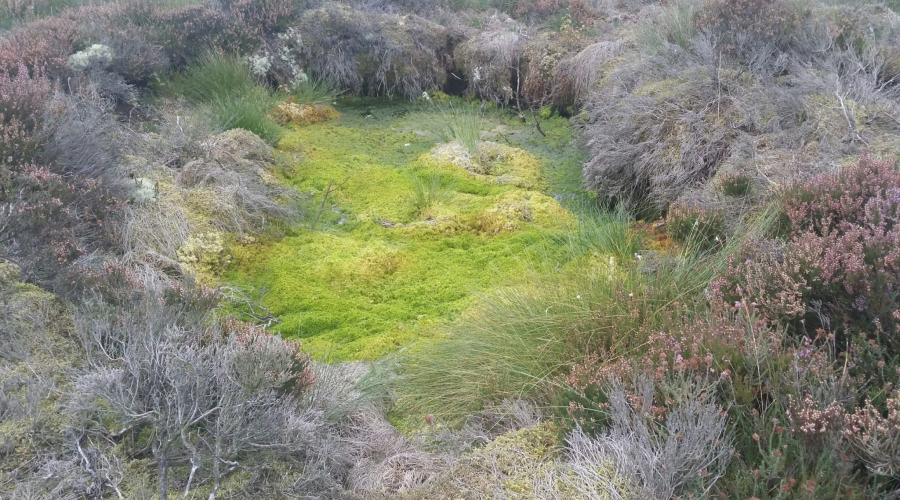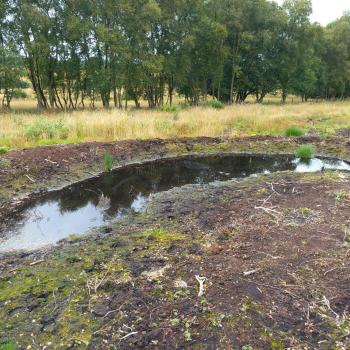
Peatland ACTION case study: What’s the connection between peat and our industrial past?
(Bankhead Moss Wildlife Reserve)

Peatland ACTION case study: What’s the connection between peat and our industrial past?
The answer lies in lint holes, and lots and lots of sphagnum moss.
Bankhead Moss Wildlife Reserve
Bankhead Moss is a lowland raised bog in Fife - a rarity in that part of the world. A Scottish Wildlife Trust wildlife reserve and Site of Special Scientific Interest (SSSI), restoration work here aims to raise the water table again to bring back the wildlife that make this site so special.
Bankhead Moss suffered badly from peat cutting in the past, leaving the site’s raised dome literally high and dry. It was surrounded by the steep banks left by the peat irons slicing down into the bog, along with a large land drain, and was quickly colonised by woodland. Lint holes dug to process flax also left a legacy of spoil ridges that made the bog surface even more ragged. Two phases of intense restoration work were needed to help the process of recovery and rewetting on this much-damaged peatland. But sphagnum is now beginning to recolonise, while pools dot the surface, telling of a rising water table and a peatland that’s beginning to function again.
Peatland restoration at Bankhead Moss
In 2015-16 the Scottish Wildlife Trust secured Peatland ACTION funding to install plastic dams, and remove the mature woodland and self-seeded birch from across the main dome of the peatland. While this work began to improve the condition of the peatland, too much water was still being lost from the steep sides of the peat dome to allow the water table to rise, and the sphagnum mosses struggled to recolonise.
As a result a second phase of work was funded through Peatland ACTION in 2022 to slow the flow off the moss and raise the water table again. Contractors installed a 260m long deep trench bund along the contour of the northern sloping edge of the Moss to help retain more water at the bog surface and reduce the amount of sub-surface flow reaching the drain to the north. The bund was constructed in line with Peatland ACTION guidelines and included 8m long bund extensions spaced at 10-20m intervals at right-angles to the main bund.
This peatland restoration project was funded by NatureScot Peatland ACTION.
© Rory Sandison/Scottish Wildlife Trust
While a low ground pressure mini-excavator was on site, the contractor also tracked the machine over 2.7ha of the main dome to help flatten and compact some of the spoil ridges to create a smoother surface, while protecting the integrity of any historic lint holes, and avoiding Scottish Wildlife Trust’s monitoring infrastructure.
The contractor installed a total of 15 additional plastic pile dams across the site - seven 3m wide dams with a single beam support; and eight 2m wide dams with no timber bracing.
Finally a small 35m section of relict eroded drain to the extreme south of the site was reprofiled by machine.
Bankhead Moss - Challenges and benefits
As a small project in a largely peat-less part of the country the first challenge was to find a contractor willing and able to do the work. Eventually an experienced firm took on the job, and successfully tackled some of the long-running issues that were preventing the bog from rewetting.
The next challenge to overcome was that all the machinery had to be offloaded on the main road and driven down the edge of a neighbouring farmer’s field to access the site through the lag fen. While there was a legal right of access, Rory Sandison, the then site manager, was keen to ensure that this was done sensitively and with the agreement of the landowner, to ensure Scottish Wildlife Trust could maintain a good working relationship with their neighbour.
The moss attracts significant academic research from local universities, particularly St Andrews and Dundee. It also enjoys committed support from local Trust members. Scottish Wildlife Trust spent considerable time before the work took place explaining the chosen management options, and how they would result in benefits to the biodiversity of Bankhead Moss.
They also explained that although the work would inevitably disrupt some of the long-term hydrological and botanical monitoring regimes, with support from Peatland ACTION and the careful work by the contractors, this impact would be minimised.
Detailed maps backed up with coloured canes marked areas that had to be kept free from disturbance (for example around the hydrological monitoring points) and areas which needed it to be kept to a minimum. This approach gave contractors a clear idea of which areas to avoid, meaning that they could get on with the work with confidence.
Bankhead Moss - Industrial past
The moss has a network of lint holes across its surface. These were originally excavated in the 18th and 19th centuries and were used to process flax. These excavations were then used during the Boer and First World Wars as sources of sphagnum for wound dressings, as they often have the best examples of raised bog habitat - and therefore sphagnum moss - on the site.

Today some of the best bog habitat is found in these features.
©SWT
The Trust continued excavating new lint holes until fairly recently. They identified some of these as areas to avoid, and allowed some to become horseshoe bunds. By including some of these areas they hoped to give the bunds a kick start to restore the raised bog habitat. Some were also protected as academic research areas free of disturbance, and of course it was important to retain this important social heritage of the site. The contractors went above and beyond expectation in adhering to these considerations.
Bankhead Moss - Successful outcomes
Ground smoothing (involving the flipping of stumps and smoothing over the peat) on the former Scots pine area worked very well. Huge amounts of problem scrub, brash and debris were buried or used to infill the one ditch which crossed the peat dome, allowing the water table to rise again. Horseshoe bunds created over the dome were also successful, quickly holding water and supporting sphagnum.
"This was the moss’s last chance to be a raised bog”.
Some research carried out at the bog (as yet unpublished) suggests the bog may be functioning extremely well with better than average sphagnum accumulation.
While there are still some water table issues in parts of Bankhead Moss, peatland restoration work here has enabled the Trust to take a great step forward in managing the site as a lowland raised bog. Without this and the 2016 Peatland ACTION funded project it’s safe to say that management of Bankhead Moss as a raised bog would have been impossible.
For further information, or to get involved with PeatlandACTION
- We offer funding for suitable peatland restoration projects across Scotland
- We offer, where appropriate, multi-year funding
- We fund up to 100% of the capital costs
- We fund much of the pre-application work, for example, peat depth surveys and feasibility studies
- We have officers who can help design your project, offer advice on restoration management and assist you to complete your application and supporting information.
Peatland ACTION case studies: We demonstrate links between peat condition and: fisheries; grouse; carbon storage; wildlife; landscapes; human history; and so much more.
If you would like to contribute to the on-going work of Peatland ACTION please contact [email protected].
For further information: www.nature.scot/peatlandaction
Visiting Bankhead Moss Wildlife Reserve: https://scottishwildlifetrust.org.uk/reserve/bankhead-moss/








